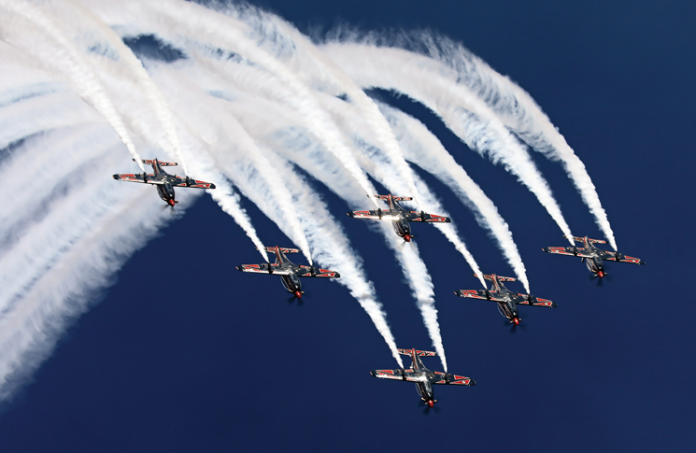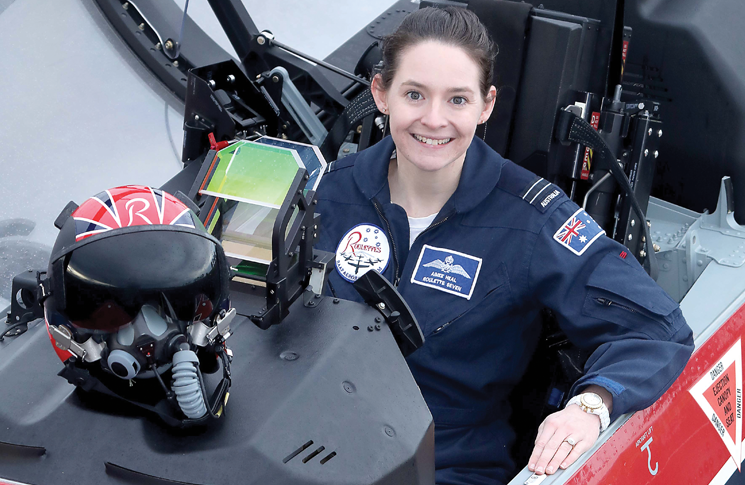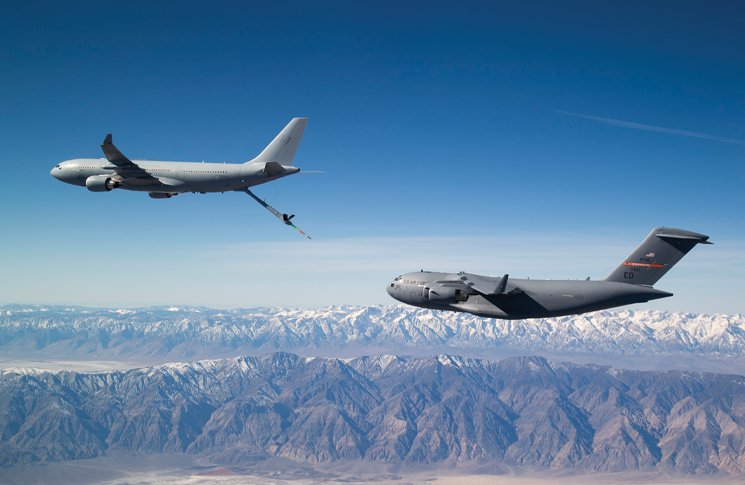
Years before becoming Roulette Seven, the non-flying member of the aerobatic team, Aimee Heal faced a serious incident with only a small number of hours in her logbook. This laid a foundation of diligence and quiet confidence that has served her well
When the left engine of the RAAF King Air began to fail, all the homilies, policies and cliches of safety culture suddenly became real for Flight Lieutenant Aimee Heal.
This was her first in-flight emergency and, although it didn’t seem that way at the time, it was a ‘Goldilocks’ incident – neither trivial nor unmanageable – a severe but fair trial of all she had learnt. Later in her career she would routinely manage the exacting dance of hooking a huge C-17 transport aircraft onto her Airbus A330 tanker, but the dead engine came early, only days after she was posted to Townsville as a newly‑minted pilot.
‘There were a few things that really took me by surprise,’ she says.
‘We had an oil pressure problem and the checklist directed us to shut down the engine. Because I had practiced it quite a few times in the sim [simulator], I understood where the checklist had to go and what we had to do. But when you actually get to that line in the checklist where it says, “If this happens, shut down the engine”, you definitely take a breath and go, “Okay, am I really ready to shut this engine down?”.
‘When I had looked out the window in the sim, the prop was dead still. And I thought, that really wouldn’t happen, I would expect the prop to still be turning, at least a little bit, but no – when I looked out of the aircraft when I had engine failure, the prop was dead still in the air. And that was like, “okay, that engine is completely [gone]”.
‘We had been climbing out, passing flight level 140, so we started running the checklist and shut down that engine. It took about 40 minutes, from the time we took off, then levelled off, turned back and landed.
‘This was early in my career and it put me at ease that the checklists we have really work, the procedures we have in place do achieve a safe arrival back into the destination.’
Aimee says the experience was not particularly scary because of her training. ‘It didn’t necessarily surprise me but the thing I took away from it was that I just went in, did the checklists, made the decisions, worked through the process, got back on the ground,’ she says. ‘But afterwards, I really had an adrenaline surge – I looked back and was quite shaken from what had happened, but at the time, all my training just kicked in.’
Aimee had an audience for that landing – fellow members of the then 38 Squadron. ‘As soon as the PAN was declared, everyone in the squadron was notified and because we were coming back to our home base, a lot of people were there, coming to make sure we were all okay after we landed,’ she says.
‘I definitely took away a lot from that experience – those checklists are written for a reason and no matter how well you know them, just getting them out and going through the physical actions of reading through the checklist – even if you know it from memory – actually calms you and puts you in the rhythm of how you’re going to deal with the emergency.
‘For me, it’s like the anchor – no matter what happens, if I go back to aviate, navigate, communicate, administrate, at least that gives me time, even if it’s only half a second, to take a breath, think about things and then push on, rather than just jumping straight into something and making the wrong decisions because you’re taken by that shock factor. ‘

A culture of safety
Aimee says Defence gives top priority to maintaining a just safety culture where individuals can learn from their error.
‘For us in the military, it’s not necessarily about what you did wrong – it’s about what we can learn from the event,’ she says. ‘When we conduct safety investigations, it’s not about punishment, it’s about the learning outcomes and improvement. We look at whether you can learn something from it versus whether it’s just a human error.
‘I’ve done quite a lot of research and courses in human error and I find it really fascinating that the errors we make in the cockpit are exactly the same type of errors we make at home or in the office, such as, I left my piece of paper on the photocopier – oops, that is human error and those errors are still made in the cockpit, it’s just the possible outcome that differs. Breaking that down and understanding what is impacting you when you make those errors is a really powerful thing.
‘Safety culture is an integral part of squadron life. An example of this is in the morning brief – we are always asked, has anyone got any safety points? People talk about their errors, because it’s inherent, it’s going to happen, we can’t eliminate it, but what’s important is the processes we have in place to try to reduce the impact of those errors.
‘I really like the idea of the Swiss cheese model. We put in barriers to try and stop the holes in the cheese lining up and causing a catastrophic event, but those errors are like walking out the door and forgetting your keys – those sorts of errors that we make day-to-day as humans, it’s just part of human nature.’
The use of checklists is ingrained into people working in the aviation sector, along with openly discussing worst case scenarios, Aimee says.
‘We’ve been using checklists for such a long time that it is just the norm for us, it becomes so ingrained in us, whereas that’s not necessarily the same for other industries,’ she says.
‘If you’ve been involved in aviation, not necessarily as a pilot, but as an air crew or engineer, you’ve been immersed in a safety culture – it is a surprise to learn how other industries operate.
‘Even just briefing on the worst case scenario before you go flying is the norm for us, but not necessarily for other sectors.
‘I think people think pilots are pessimistic because we always brief the worst case, but I don’t see it like that at all. I just think it’s preparing, then anything that comes along will be better handled because we are prepared.’
It’s about how you dust yourself off, pick yourself up and keep working hard to try to achieve whatever your goal is.
Dust yourself off
As Roulette Seven, the non-flying member of the team, Aimee manages the Roulettes and does commentary when the team does a display. She flies the spare Pilatus and is part of the seven-ship formation while positioning for displays during Roulette transits.
Her role means she is frequently asked to speak to other pilots and pass on her knowledge and tips. She recently took a PC-21 to Broken Hill to speak to delegates at the Australian Women Pilots’ Association conference.
‘One of the things I always like to raise is that failure is part of life and the aviation environment,’ she says. ‘There’ll be some things that you do really well but others you struggle with throughout your career. And just because you fail something doesn’t mean it’s the end of your career.
‘There have been many cases in my career where I’ve stumbled and failed at something but it’s all about your resilience and how you can pick yourself up. You might have one day when you’re in a bad mood and upset by that failure, but it’s about how you dust yourself off and keep working hard to try to achieve whatever your goal is.‘In my public role at air shows, people often say, “It’s great to see a female member of the Roulettes”. And my response is, “There have been women military aviators since the Second World War”. So this is not a new concept but it makes me realise there aren’t enough girls out there, that it hasn’t become the norm. That surprised me because I’ve worked with some fantastic women who have mentored me throughout my career and are also doing amazing things in the military.’
Starting early
Flight Lieutenant Aimee Heal began her aviation journey at school after her father took her for a flight in a helicopter. ‘Then my Dad took me out to the local aeroclub where I was able to get my student pilot’s licence and go flying – there’s nothing like it. Later, I wasn’t expecting the first solo when my instructor got out and there was an empty seat beside me – but that was the first time I got that real thrill and I suppose I’ve been chasing that ever since.’
After completing a degree at the Australian Defence Force Academy in Canberra, Aimee was accepted into flying training. After graduating from the 2nd Flying Training School at RAAF Base Pearce, she was posted to Townsville and later to Amberley where she flew the KC-30 tanker, the military version of the A330.
‘I flew around the world on exercises, working with different coalition partners, doing air-to-air refuelling,’ she says.
Fighter aircraft such as the Hornet are refuelled by a drogue extending from each wing of the tanker, whereas large aircraft such as C-17s hook up to a telescopic boom extending from beneath the KC-30. ‘You have 2 big aircraft traveling at 500 kilometres an hour, trying to contact and move fuel from one aircraft to the other,’ she says. ‘We do a lot of practice and have procedures in place if something is not right – breakaway procedures that are like a go-around.
‘You really notice when refuelling a heavy aircraft like the C-17 – you get quite a big rate of climb or descent, depending on if they’re pushing in or going out, up to 1000 feet per minute, it’s not as smooth as what people might think.’

Flying in formation
The tanker is a challenging aircraft to fly, but pilots learn to manage the momentum of a large airframe. ‘Being ahead of the aircraft when you need to slow down and descend is one of the things you need to be aware of and be on top of,’ Aimee says. ‘And it’s such a contrast to go from flying the KC-30 to the PC-21 – when you want to turn, you can do it so easily and therefore you have much more flexibility within the airspace we operate in. The PC-21 has the benefits of a large aircraft such as a state-of-the-art autopilot and flight management system.’
Next year Aimee hopes to become an instructor which is the traditional pathway to flying in Roulette displays – and that will be another leap forward for this inspirational aviator.


Great example for women to follow in Aviation
Wonderful to hear from a very bright young lady with such motivation and skills my hat goes of to you Aimee
Fantastic and uplifting story. Keep on soaring.